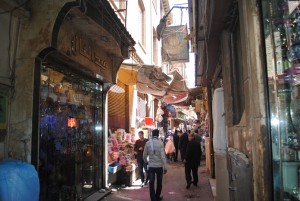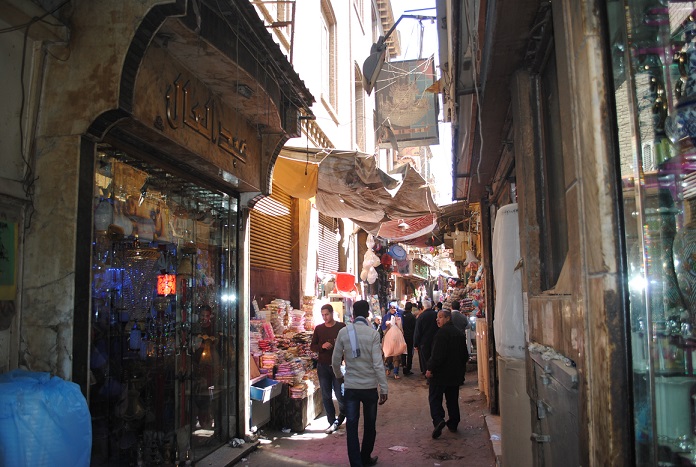
Abdel-Rahman Sherief
Darb Al-Barabra has always been representative of how Egyptian society used to be; it once was a melting pot for many different cultures that lived peacefully side by side in this old part of Egypt’s capital.
Unfortunately it is not often visited by tourists. The area is not commonly recommended by tour operators to visit even though it is located near a few famous historic sites of Cairo and has an important place in Egyptian history and culture.
Darb Al-Barabra is located in the narrow, winding streets located between Al-Azhar Street and Al-Attaba Square. The name in Arabic means the Berbers’ Area and from the 19th century on the area was inhabited by Algerians, Moroccans and Africans who are all called Barabra by Egyptians.
Beside the glittering chandeliers that hang at the entries of stores and the attractive colourful artificial plants that dangle inside the stores, the place is teeming with many historic mansions, a remarkable Catholic church and a synagogue. According to Ali Jamel, one of the elder residents, Darb Al-Barabra used to be inhabited by Jews and foreign merchants, and was a centre for sweets and candy-making in Cairo. “Most of the sweet ateliers and shops located here were owned by Greek and Jewish merchants,” Jamel said.
Jamel now owns his own polyester textile store, as the whole area has become the home of decoration, beads, chandeliers and sweets stores, all owned by Egyptians unlike the old days. “We used to live peacefully with the Jews and foreign merchants and all the stores here were owned by foreigners who used Egyptian labour,” Jamel said.
A beautiful ancient Catholic church is located at the beginning of the area and Jamel said the French ambassador to Egypt used to visit this church in an annual occasion during a spectacular ceremony, but this event stopped in 1955.
“The area ends at Al-Geish or Army Street, which was paved on orders of King Fouad on the occasion of the birth of his son and heir Farouk, who later became Egypt’s king,” said Karim Costa.
Karim Costa, or Kimo as he prefers to be called, has also lived in the area for a long time and he is called Costa after a Greek patisserie where he used to work. “The Egyptians, Sudanese and Africans who used to work in the foreign-owned shops and bakeries inherited these shops after the foreigners left Egypt,” Costa said.
Deep inside Darb Al-Barabra, among the large amount of buyers and sellers, a number of beautifully adorned buildings and mansions are located. A deserted synagogue still exists there but it has been sealed by the Egyptian authorities and nobody is allowed to enter it.
The area is famous now for being the centre of things you need to prepare a wedding feast or hold a seboua’, the traditional Egyptian celebration to welcome newborns into the world. All seboua’ requirements, from candies, candles to dolls and whatever else you may want can, be found there.
Darb Al-Barabra is a testament of Egyptian history and society; it has witnessed many political and social fluctuations and its buildings, homes and older inhabitants hold many stories which reflect the authenticity and the specialness of the area.




